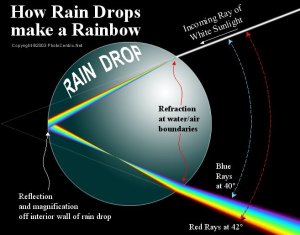

After a particularly nasty storm (if you’re visiting somewhere BESIDES Oregon or Washington), it’s always nice for a cloudless blue sky to make an appearance. But it’s even better if it’s accompanied by a colorful rainbow. I’m assuming that everyone has seen one at one point or another (the vision impaired aside). But how closely have you looked at one, or studied its form?
Rainbows are formed through a process called refraction. When a wave is traveling at any angle that isn’t exactly 90 degrees, its line of travel will change when it passes the boundary between one medium and another. Each with different consistencies. Its path will refract, or become “bent.” But the direction of the bending of the wave is highly dependent on the relative 332d of the two (the changes in speed between the two mediums influences the directions the waves will travel).

For example, a wave will bend in the opposite direction from the direction it started in if it’s moving from a fast medium to a slow medium. Also, light isn’t the only wave that experiences refraction; both water and sound waves do the same.
But returning to light refraction, when a beam of light passes through a glass prism, the colors of the light will be broken apart into their specified frequencies, which move through matter at different speeds. One of the slower traveling colors will bend more sharply than the color that is traveling more quickly. If the glass ‘bends’ the light twice, in a prism, the colors generated can be seen much more easily, which is called dispersion.
Now, when it rains (mists, sprays, and airborne dew included), drops of said water (each with different shapes and consistencies, kind of like a glass prism) can refract and disperse the light in our atmosphere in a similar way if the light is reflected in the rear of the water drop and refracted again while leaving it, where it will begin traveling through the air at its original speed. If the conditions are appropriate (with the sunlight hitting the drops of water at a low angle), a rainbow can be formed. The different wavelengths of visible light separate into their individual colors, as light is composed of all sorts of different colors that we can’t typically see.
So. Lets summarize. In order for a rainbow to appear:
- We need water. Be it during rain, dew, spray, or whatever else.
- Light strike the water, some of it is reflected (like seeing your figure in a pool or clean lake), while the rest is refracted (or bent).
- The white starlight is divided into component colors, corresponding to its own wavelength. Each of which, travel at different speeds as they pass from one medium to another.
- If a certain angle is reached as the light travels from a more dense medium to one that is less dense, total internal reflection occurs (in the rear of the raindrop), which is pivotal for the creation of a rainbow. Any other angle will result in the light continuing on its path through the other side — away from the would-be viewer.
- As the light ray begins to change its speed when entering the raindrop through a more dense medium (the water), it will again change as it exits the raindrop into a a less dense medium (the air), where it will continue to speed up and bend away from the normal line.
- Lastly, the component colors are dispersed, separating each out into separate, discernible colors… a rainbow!
Now, some of you may be surprised to learn that rainbows never have a pink band. Instead, you will see red on one side followed by orange, yellow, green, blue, and indigo, with violet (always in the same order) on the opposite side, each corresponding to a certain wavelength on the visible part of the electromagnetic spectrum. We never see pink light because ‘pink’ (and every slight variation of pink) doesn’t exist. Instead, pink is a mixture of both red and blue light, but our eyes are not sensitive enough to see both as separate colors in their own right, therefore, they are perceived as one color.
So if any of you gals (or guys, as we don’t like to discriminate) are like me, with pink being your favorite color, just know that it’s more appropriate to call ‘pink’ minus green. Because essentially, pink is just the left overs of white light without the green. This is a great video by MinutePhysics about “minus green.” Have you ever heard of a moon halo? It’s created in the same way a rainbow is, but under slightly different conditions (and, it’s created by the Moon, of course). Read about theme here.